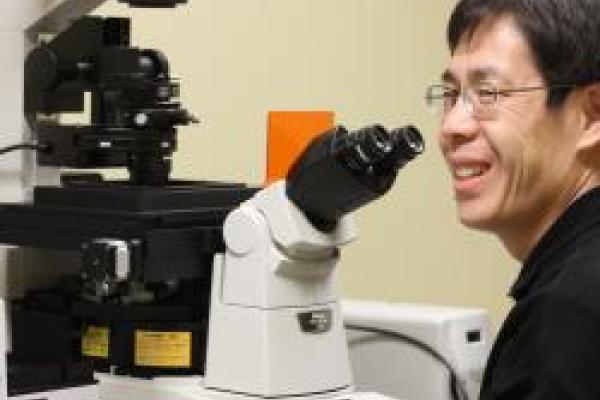Molecular Geneticist Receives American Cancer Society Grant

Jian-Qiu Wu’s cancer genetics research just received a huge boost. Armed with a new four-year, $720,000 Research Scholar Grant from the American Cancer Society, the molecular genetics assistant professor is poised to take his work to new levels.
These highly sought after grants are the equivalent of National Science Foundation CAREER Awards; both make significant investment in the research programs of the nation’s most promising young scientists.
The grant funds the project Roles and Regulations of Rho GEFs in Fission Yeast Cytokinesis and will support work that focuses on the molecular mechanisms of cytokinesis in the fission yeast S. pombe. It also enhances the ongoing, overarching mission of Wu’s laboratory: to understand the roles of cytoskeletal and signaling proteins in cellular asymmetry and cell division in normal and in cancer cells.
“It is very important to select the correct model system to address your central questions; each system has its advantages, but for our research we get the most knowledge from yeast,” Wu said.
S. pombe has many attractive qualities that make it a favorite model system for the analysis of cytokinesis. It is easy to control genetically and lends itself well to microscopic analysis; has highly efficient homologous recombination; and has a small, fully sequenced eukaryotic genome.
“Perhaps most importantly, “Wu said, “it carries out cytokinesis in much the same way that animal and human cells do.
“The majority of proteins involved in cytokinesis are evolutionarily conserved so that much of what is learned about these proteins in fission yeast is applicable to human cells.”
Since the Nobel Prize winning cell-cycle work of British scientist Paul Nurse more than three decades ago, geneticists have identified more than 130 evolutionarily conserved genes that contribute to cytokinesis in S. pombe.
“Now, although we know some of what is happening, there are still many questions to answer,” Wu said.
From biology classes, we may remember that cytokinesis divides cellular components into two daughter cells at the end of the cell cycle. When coordinated with the generation of cellular asymmetry, cytokinesis can produce diverse cell types in multicellular organisms, playing a crucial role in both cell proliferation and cell differentiation.
A better understanding of the process is crucial to cancer researchers like Wu, as defects in or miss-expression of many genes involved in cytokinesis may have the potential to result in cancer cell formation and tumor development.
“Studying the roles of cytokinesis proteins and investigating cytokinesis defects in human cancer cells is incredibly important, contributing not only to understanding the pathogenesis and progression of cancer, but eventually providing a path to a cure,” Wu said.
Wu already has an impressive track record. His previous studies established the spatial and temporal pathways for the assembly and constriction of the contractile ring during cytokinesis in fission yeast; measured the global and local concentrations of 30 cytokinetic proteins; and discovered "nodes" as precursors for the contractile-ring assembly.
To test the node model rigorously, Wu and his colleagues used high spatio-temporal resolution microscopy and mathematical modeling to study the assembly of the contractile ring, finding that nodes condense into a contractile ring through a search, capture, pull, and release mechanism.
During the next several years, work in his laboratory will continue to explore the molecular mechanism of cytokinesis in S. pombe using a combination of cellular, molecular, biochemical, genetic, microscopic, and mathematical approaches.
The Wu laboratory space on the sixth floor of the Biological Sciences Building is filled to overflowing. Five graduate students: Valerie Coffman, I-Ju Lee, Reshma Davidson, Ning Wang, and Yihua Zhu; along with four undergraduate researchers: Leigh Anne Diener, Michaelanne Sauer, Cally McGee, and Kersey Schott, enthusiastically apply themselves to these research questions. Two new postdoctoral researchers will join the lab soon. Wu’s talented group is highly productive: 16 papers have been published since he set up his laboratory at Ohio State five years ago.
One suspects this rich research environment is due not just to the work itself, but to Wu’s quiet exuberance; he is clearly passionate about the work his group is engaged in. “I guess I have always been interested in nature, driven by curiosity and the desire to solve fascinating problems.”
This new grant, which among other things, allows Wu to support more graduate students and postdocs, along with the arrival of the department’s uber-powerful spinning disk confocal microscope will certainly give new momentum to the upward trajectory of his work.
Wu is delighted at this confluence of events. "The Research Scholar Grant is a significant national award and It is very important to have a sophisticated microscope as our work is very visual,” Wu said.
“In the long term, we also plan to apply our knowledge of cytokinesis to other systems by studying orthologs of fission yeast cytokinesis proteins in cancer cells,” Wu said. “We hope that some of these proteins will become novel targets for cancer therapy and treating other human diseases.”
Wu has a joint appointment in the Department of Molecular and Cellular Biochemistry, College of Medicine.
